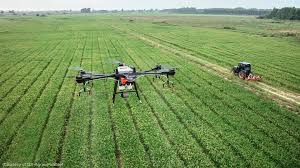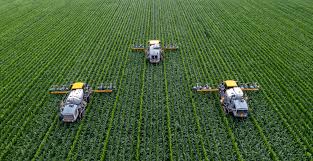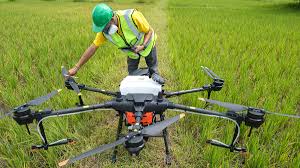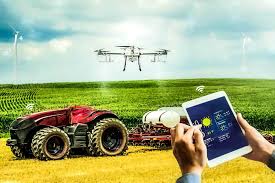Agriculture has come a long way from traditional methods to advanced technological innovations that boost productivity, enhance crop quality, and conserve resources. Agricultural technologies refer to tools, machines, and systems that farmers use to grow crops, raise livestock, and manage the entire farming process more efficiently. These innovations help improve yields, reduce environmental impact, and make farming easier and more profitable.
This article will explore key areas in agricultural technologies, including precision farming, artificial intelligence (AI), and biotechnology, all designed to enhance modern farming practices.
Evolution of Agricultural Innovations
Over the centuries, agriculture has evolved drastically. From manual tools and animal-powered plows to modern machines and high-tech systems, each stage of innovation has made farming more efficient and productive. Let’s explore how agricultural technologies have progressed over time:
1. Early Tools: Simple hand tools such as hoes and sickles were used by early farmers to till soil and harvest crops manually.
2. Mechanization Era: The invention of the plow, tractor, and mechanical harvesters revolutionized farming by increasing the speed and efficiency of planting, harvesting, and transporting crops.
3. Green Revolution: The mid-20th century saw the introduction of high-yield crop varieties, chemical fertilizers, and pesticides, which significantly boosted global food production.
4. Modern Technological Advancements: In the 21st century, farmers are now using satellites, drones, precision farming tools, and advanced irrigation systems to make farming more data-driven and efficient.
These innovations have transformed farming from labor-intensive tasks to precision-based operations that use modern equipment and software to maximize yields.
Precision Farming Techniques

Precision farming, also known as precision agriculture, is an advanced farming approach that uses technology to optimize crop production by managing variations in the field more accurately.
It involves using data and technology to ensure that crops receive exactly what they need for optimal growth. The goal is to increase efficiency, reduce waste, and boost yields.
1. GPS Technology: GPS (Global Positioning System) allows farmers to map their fields with high accuracy and guide tractors and machines to plant, fertilize, and harvest crops in straight lines. This reduces overlapping and saves time, fuel, and resources.
2. Soil Sensors: Soil sensors measure moisture levels, nutrient content, and soil temperature in real-time. This information helps farmers apply the right amount of water and fertilizer at the right time, leading to healthier crops and reduced waste.
3. Drones: Drones equipped with cameras and sensors can fly over fields to capture images of crops. These images show the health of crops, identify problem areas, and help farmers make informed decisions about when to irrigate, apply fertilizers, or treat pests.
4. Variable Rate Technology (VRT): VRT allows farmers to apply different rates of inputs, such as seeds, water, and fertilizers, based on the needs of specific areas within a field. This helps reduce the use of inputs while increasing crop productivity.
Precision farming saves resources and enhances crop yields by tailoring farming practices to specific conditions in each field.
Role of Artificial Intelligence in Agriculture
Artificial Intelligence (AI) is becoming increasingly important in agriculture by helping farmers make data-driven decisions, improve efficiency, and reduce labor costs. AI uses machine learning, big data, and automation to improve various aspects of farming.
1. Crop Monitoring: AI-powered systems can monitor crop health by analyzing images taken from drones or satellites. These systems can detect early signs of diseases, pests, or nutrient deficiencies, enabling farmers to take timely action.
2. Automated Machinery: AI is used to develop self-driving tractors, harvesters, and other agricultural machines. These machines can operate autonomously, reducing the need for human labor while increasing precision and efficiency.
3. Predictive Analytics: AI algorithms analyze historical and real-time data to predict crop yields, weather patterns, and potential risks such as pest infestations. This helps farmers plan better and make informed decisions.
4. Smart Irrigation Systems: AI is used to optimize water usage in irrigation systems by predicting crop water needs based on weather conditions and soil moisture levels. This reduces water waste and ensures crops get the right amount of water.
The integration of AI into agriculture allows for more accurate decision-making, reducing risks and increasing the efficiency of farming operations.
Read Also: The Most Lucrative between Production of Fish Fingerlings or Raising them to Table Size
Advancements in Biotechnology for Crop Improvement

Biotechnology refers to the use of living organisms, cells, or genes to develop new products or improve existing ones. In agriculture, biotechnology is widely used to enhance crop quality, increase resistance to pests and diseases, and improve yields.
1. Genetically Modified (GM) Crops: GM crops have been developed to resist pests, tolerate herbicides, and withstand harsh environmental conditions such as drought. For example, Bt cotton and Bt corn are genetically modified to produce a toxin that kills certain insects, reducing the need for chemical pesticides.
2. CRISPR Gene Editing: CRISPR is a gene-editing technology that allows scientists to make precise changes to a plant’s DNA. This can be used to develop crops that are more nutritious, drought-resistant, or pest-resistant.
3. Disease Resistance: Biotechnology has been used to develop crops that are resistant to diseases such as blight, rust, and viruses. This reduces the need for chemical treatments and increases crop survival rates.
4. Biofortification: Biotechnology is also being used to increase the nutritional value of crops. For example, Golden Rice has been genetically modified to produce higher levels of vitamin A, helping to address nutrient deficiencies in developing countries.
Biotechnology plays a crucial role in developing crops that are more resilient, nutritious, and productive, ensuring food security in the face of global challenges such as climate change and population growth.
Smart Irrigation Systems
Smart irrigation systems are an advanced technology designed to optimize water usage in agriculture. By using sensors, data analytics, and automation, smart irrigation systems help farmers apply the right amount of water to their crops at the right time, reducing waste and improving water efficiency.
1. Soil Moisture Sensors: These sensors monitor the moisture levels in the soil and provide real-time data to farmers. This helps them decide when to water the crops and how much water to apply, ensuring crops receive the ideal amount of water without over- or under-watering.
2. Weather Forecast Integration: Smart irrigation systems can integrate weather data, such as rainfall forecasts, to adjust watering schedules automatically. If rain is expected, the system can delay irrigation, saving water and preventing waterlogging of the soil.
3. Drip Irrigation Systems: Drip irrigation is a method that delivers water directly to the root zone of plants through small tubes. Smart systems control this process based on crop needs, reducing water evaporation and runoff, and ensuring efficient water use.
4. Remote Control and Automation: With smart irrigation, farmers can remotely monitor and control their irrigation systems through apps or software. This allows for more precise management and reduces the time spent manually adjusting irrigation settings.
Smart irrigation systems not only conserve water but also improve crop health by providing water when and where it’s needed most, making them an essential tool for sustainable agriculture.
Read Also: The Ultimate Step-by-Step Guide to Vegetable Gardening
Drones and Robotics in Modern Farming

Drones and robotics are revolutionizing the way farming is done by automating tasks, improving precision, and reducing labor costs. These technologies allow farmers to monitor large fields, plant crops, and harvest efficiently with minimal human intervention.
1. Crop Monitoring Drones: Drones equipped with cameras and sensors fly over fields to capture high-resolution images of crops. These images provide farmers with detailed information on crop health, growth patterns, and potential problem areas, such as pest infestations or nutrient deficiencies.
2. Precision Planting Robots: Robotics technology has enabled the development of automated machines that can plant seeds with precision. These robots ensure uniform planting and reduce the risk of seed waste, ultimately improving crop yields.
3. Autonomous Harvesting Machines: Harvesting is one of the most labor-intensive tasks in farming. Robots are now being developed to autonomously harvest crops such as fruits and vegetables, reducing the reliance on manual labor and increasing efficiency.
4. Pesticide and Fertilizer Drones: Drones can be used to apply pesticides and fertilizers with great accuracy. This technology reduces the amount of chemicals used by targeting only the areas that need treatment, promoting both environmental sustainability and cost savings.
The use of drones and robotics in agriculture is reducing labor costs, increasing productivity, and allowing for more precise farming practices, ultimately helping farmers manage their fields more efficiently.
Sustainable Agricultural Practices
Sustainable agriculture focuses on using farming methods that protect the environment, preserve natural resources, and support long-term agricultural productivity. As the global population grows, the demand for food increases, making sustainable practices more critical than ever.
1. Crop Rotation: Crop rotation involves growing different types of crops in the same field across different seasons. This practice helps prevent soil depletion, reduces pest and disease outbreaks, and enhances soil fertility by balancing the nutrients used by different crops.
2. Organic Farming: Organic farming avoids the use of synthetic chemicals such as fertilizers and pesticides. Instead, it relies on natural inputs like compost, manure, and biological pest control methods, promoting healthier ecosystems and reducing environmental harm.
3. Conservation Tillage: Tillage is the process of preparing the soil for planting. Conservation tillage reduces the amount of soil disturbance by minimizing plowing. This practice helps maintain soil structure, reduces erosion, and promotes carbon sequestration.
4. Agroforestry: Agroforestry is the practice of integrating trees and shrubs into agricultural landscapes. Trees provide shade, reduce wind erosion, improve soil health, and help sequester carbon, making agroforestry an important tool for combating climate change.
Sustainable agricultural practices not only protect the environment but also enhance long-term farm productivity, ensuring that future generations can continue to grow food on healthy, fertile land.
Internet of Things (IoT) in Agriculture
The Internet of Things (IoT) refers to the network of connected devices that collect and share data through the internet. In agriculture, IoT technology is being used to monitor and manage farm operations more efficiently by collecting real-time data on crops, livestock, and environmental conditions.
1. IoT Sensors for Crops: IoT sensors can be placed in fields to collect data on soil moisture, temperature, humidity, and other environmental factors. This data helps farmers make informed decisions about watering, fertilizing, and pest control, ultimately improving crop yields.
2. Livestock Monitoring: IoT devices such as GPS trackers and health sensors can be used to monitor the location, health, and behavior of livestock. This enables farmers to track their animals, detect early signs of illness, and ensure that livestock are receiving the care they need.
3. Smart Greenhouses: IoT technology is used in smart greenhouses to control lighting, temperature, humidity, and irrigation automatically. By adjusting these factors based on real-time data, farmers can create optimal growing conditions for plants, improving productivity.
4. Data-Driven Decision Making: IoT devices generate large amounts of data that can be analyzed to identify trends and make predictions. For example, farmers can use IoT data to predict weather patterns, monitor soil health, and optimize crop schedules based on data-driven insights.
The use of IoT in agriculture allows farmers to monitor their fields and livestock in real time, make data-driven decisions, and automate processes, all of which improve efficiency, reduce costs, and enhance productivity.
Agricultural technologies, including precision farming, artificial intelligence, and biotechnology, have transformed the farming industry, making it more efficient, sustainable, and productive. These innovations allow farmers to manage their fields with greater precision, improve crop quality, and reduce the environmental impact of farming practices.
As technology continues to evolve, we can expect further advancements that will shape the future of agriculture, ensuring a more sustainable and food-secure world.
Do you have any questions, suggestions, or contributions? If so, please feel free to use the comment box below to share your thoughts. We also encourage you to kindly share this information with others who might benefit from it. Since we can’t reach everyone at once, we truly appreciate your help in spreading the word. Thank you so much for your support and for sharing!
Read Also: What You Need to Know About Osteospermum

